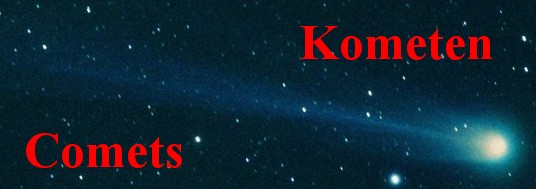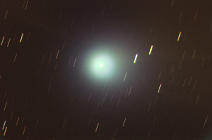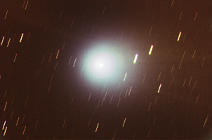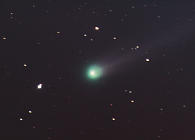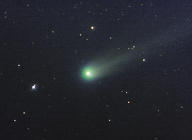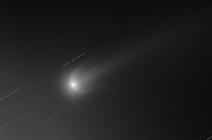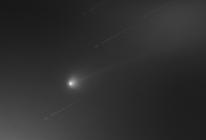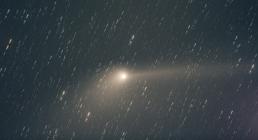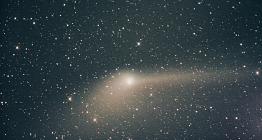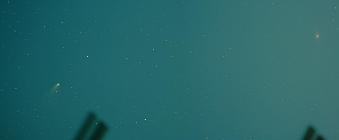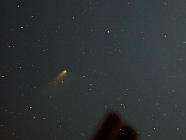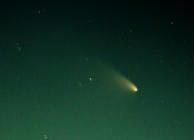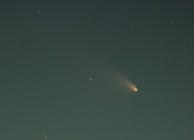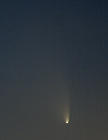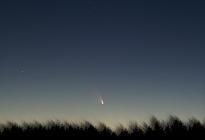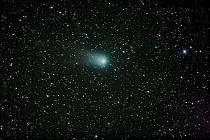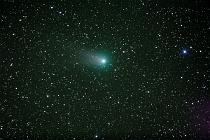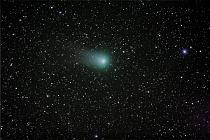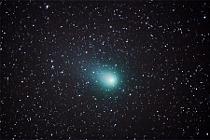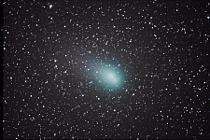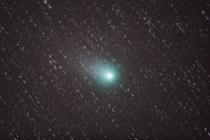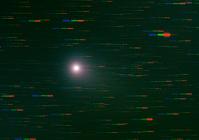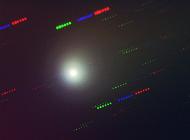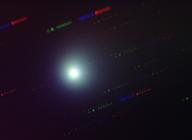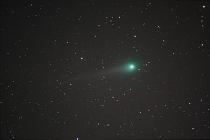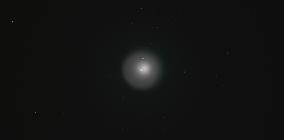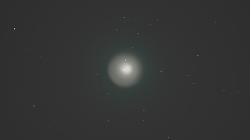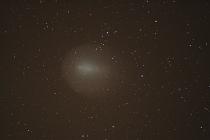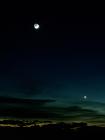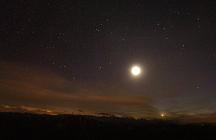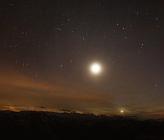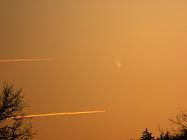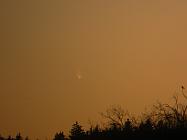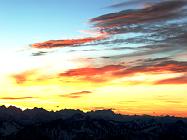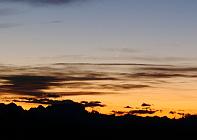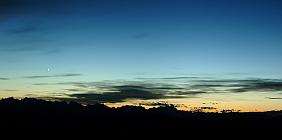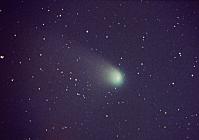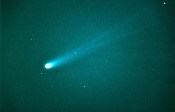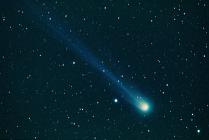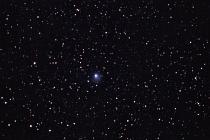Comet photography gallery!
This gallery of the most beautiful images of comets with my instruments Bismarck, Christina and ULT will be updated permanently!
All comet images can be viewed at this way.
This page presents another view into the deep of Haleys imagery archives and shows impressions of the following comets back to the year 1986, the year of Halley's comet : A very nice comet also visible with the naked eye during winter 2014/15 was C/2014 Q2 Lovejoy. In late fall 2013 both comets ISON and C/2013 R1 Lovejoy gained recognition and the last one was surprisingly nice. In spring 2013 comet PanSTARRS moved towards the northern hemisphere and was with a maximum brightness of magnitude 2 a naked eye object. In the year 2011 and in spring 2012 the comet Garradd was very interesting. The comet Lulin , was visible during February 2009 pretty well with the naked eye. The other comets presented at this page: Holmes strengthened at the end of Oktober 2007 trough an unbelievable outburst in brightness about 15 magnitudes, Mc Naught , an absolutely gorgeous comet, visible in the beginning of 2007 even during daylight. It presented a spectacular show at the southern hemisphere. The comet Machholz, the comets Neat, Ikeya Zhang and Linear, as well as the great comets of the nineties, Hyakutake and Hale Bopp. Here you'll find important comet infos.

Der Comet C/2014 Q2 Lovejoy:
Comet Lovejoy at February 11th 2015:
During X-mas 2014 this comet ran straight fast towards north and was soon a respectable object with binoculars and with a maximum brightness of about 4.5mag also pretty well visible with the naked eye. In binoculars it showed, like the days before, a nice, fine tail of about 1° length at a brightness of around 5.5mag. Both images in this row of images have been done with the 16inch Cassegrain at the Mt. Wendelstein Observatory. They are showing different interpretations of the same raw data, 7 frames in i, r and g filter 30secs each respectively. The images have been processed that way to let the core still visible. The interpretation of the colours was a bit different but the comet is obviously quite greenish.
The comet C/2013 R1 Lovejoy:
Comet Lovejoy at December 11th 2013:
After vaporization of ISON a few weeks ago Lovejoy entered the stage as a respectable x-mas comet 2013 visible with naked eyes. Indeed a few shots through the Bismarck Telescope could be made. 18 images, 20secs each, have been stacked:
The comet ISON:
comet ISON at November 15th and 17th 2013:
ISON was awaited to be a big player with great brightness. Also the Mt. Wendelstein Observatory was engaged in the observation campaign of the MPI for Solar System research. The last weeks before the perihel the brightness increased and two interesting images with the 16 inch cassegrain of the observatory could be made:
The first of these two exposures helped Dr. Hermann Böhnhardt to prove the defragmentation of the comets core. At November 28th the this comet ended its existence during the perihelion passage. More detals can be viewed at the Press release on behalf of ISON of the LMU Munich.
The comet C/2011 L4 PanSTARRS:
PanSTARRS has been discovered at June 5th 2011 with a 1.8m telescope and its large field sky survey camera PanSTARRS at Mt. Haleakala at Hawaii.
PanSTARRS at May 15th 2013:
At the final stage of the PanSTARRS campaign I succeeded at Mai 15th to exposure the comet through the Bismarck Telescope. 14 frames, 2mins each have been stacked. Done with the Deep Sky Stacker and with Registax, with Registax the comet is looking more lovely. Both tails are now clearly seperated by an angle of about 120 degrees:
PanSTARRS at April 15th 2013:
At April 15th it was again possible to take photographs of PanSTARRS at home. Again at dawn through the 135mm telelens, attached on top of the small EQ mount. At least there were clouds underway. The tails structures are now showing the dividing between dust and gas tail:

PanSTARRS at April 8th 2013:
At April 8th PanSTARRS could be found at dawn at Mt. Wendelstein. It stood close to the Andromeda Nebula M31. Despite of the bright sky it succeeded to display both objects together with the 300mm lens tracked piggyback at the 16 inch cassegrain:
PanSTARRS at March 28th 2013:
At the morning of March 28th I could watch PanSTARRS for the first time at the morning sky. Its brightness has now faded to magnitude 3 and the size of the comet in comparison to my first sighting at 15th has decreased about factor two. It is moving now pretty fast away from the Sun. Observation was made again with the 16 inch cassegrain at Mt. Wendelstein observatory and it was possible to let the EOS 350d Photonensack equipped with the 300mm telelens riding along with the scope. Both images are cutouts out of the same stack done out of 10 frames 20secs each at dawn:
PanSTARRS at March 19th 2013:
Because the comet gets observed at Mt. Wendelstein too there was for the first time a opportunity to mount the 350d equipped with the old 300mm telelens f/5.6 piggyback to the telescope. The comet was already very close to the horizon, furthermore cirrus clouds blurred the sight and five airplanes buzzed also during the exposures through the field of view. Up to 12 images 29secs each have been stacked. These images are showing also pretty impressive the dimension of PanSTARRS tail:
PanSTARRS at March 15th 2013:
At that evening it was possible to watch the comet for the first time at dusk from the Allgaeu region. It had a magnitude of 2 and was pretty well visible with the naked eye. The first row of images shows impressions above the forest. Stacking was pretty hard, Deep Sky Stacker didn't work well here. This versions had been stacked by using The Gimp and Registax. There is also a Gif animation of the setting of the comet (size 3Mb). The single shots have been made with stable camera without tracking:
A few minutes later the location had to be changed for watching the setting of the comet till the end. From the created stack out of 7 single frames 3.2secs each I've worked out a composite image with a single shot of the foreground wich represents the natural view really well:
PanSTARRS at setting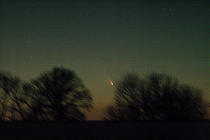 |
PanSTARRS above the Allgaeu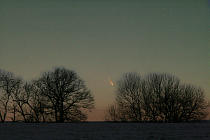 |
| Stack out of 7 single frames, therefore the foreground looks blurred. | Composite image with a 20 seconds exposed single shot. |

The comet C/2009 P1 Garradd:
Garradd at March 28th 2012:
In spring 2012 Garradd showed again its splendor. Whilst both tails pointed almost in the same direction last fall, now there are standing in right angle together because the comet has moved a lot of distance on its course around the Sun. In my opinion Garradd didn't gained brightness the last six months, it was barely visible with the naked eye. The following images have been created with the Bismarck telescope and stacked with the Deep Sky Stacker out of seven single frames 180secs each:
Garradd - comet centered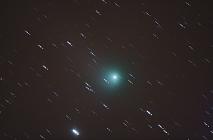 |
Garradd - comet and stars stacked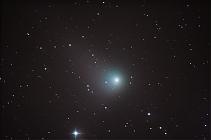 |
| Stack centered at the comet, stars appearing side by side. | Stack centered at comet and stars. |
The different stacking methods generated again interesting views. During stacking of comet and stars artefacts were created which could be removed almost completely with The Gimp. A galaxy located inside the comets corona appears bluish coloured.
Garradd at September 30th 2011 at the 27. ITT:
These row of images is showing different variations of the comet C/2009P1 Garradd, first stacked at the stars then at the core and finally at both features. The Deep Sky Stacker is able to do both procedures. All stacks are based on the same five single frames focal shots through the Christina telescope. The overall exposure time was 14m30s. Because of the final processing stage with The Gimp the images have small variations in colour and contrast. The images pictured above have been created at the International Telescope Meeting at the Emberger Alm in Carinthia. It seems to me that the comet has increased a little bit in brightness and tail length in the week since the 21st. At least the view in the 10 inch Christina was here slightly better than in the 13 inch scope a week before. Indeed the comet had two tails visible also at the images and will increase in brightness until 2012 and become a pretty spectacular object. It's worthwile to keep an eye at the informations about this interesting comet presented at the page of the section comets of the VDS.
Garradd at September 21st 2011:
At September 21st the comet was bright enough to be seen well with our smallest binoculars but just not with the naked eye. With the 13 inch Bismarck Telescope it looked impressive from the Allgäu, had a faint tail like shown in the pictures above which have been shot during this evening.
Garradd at September 12th 2011:
Garradd is bright and interesting enough that we've taken a view through the 16 inch Cassegrain at this object. Colourful single stars again have been created through sequential exposing of the colour channels during stacking at the wandering comet. The raw images have been taken from our night observer Michael Schmidt.

The comet C/2007 N3 Lulin:
Lulin at March 4th 2009:
With the 16 inch telescope at the Mt. Wendelstein Observatory I've also exposed Lulin. The camera there installed takes b/w images through colour filters. Therefore RGB images have to be generated via stacking thus generating the funny colour effects at the stars, because all images have been centered at the comet. Also a Gif animation done out of all 17 single frames was made. Filesize of this animation is already 4.5Mb!
Lulin at February 28th 2009:
From the Allgäu region Lulin glared very impressive and was also visible pretty well with the naked eye. The images above have been made through the good old 400mm Beroflex lens and were stacked out of 7 single images, centered first at the comet than stacking starfield and comet seperately and finally combined together again. One single image is showing in comparison a unmanipulated view. The comets path through the stars is shown impressive by this Gif animation (2.4Mb in size). In between also clouds came by.

The Comet 17P/Holmes:
Holmes, November 1st 2007:
Holmes bulged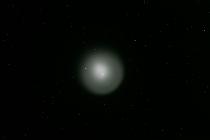 |
with outer coma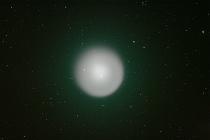
|
| The diameter is now ca 12 arcminutes. Stack out of 11x20s exposures. | The outer regions are again displayed here. |
Holmes is now filling the 350D field of view in Bismarck's focal plane almost completely. The single frames also from October 28th have been shot with 20 and 10secs. The impression was most spectacular, even with naked eye or binoculars. At the Astrotreff there is by now a great image gallery.
Holmes at October 28th 2007:
After a longer period of bad weather I could see Holmes at October 28th for the very first time and was overwhelmed of its enormous brightness. With it's 2.6mag it is an easy object for the naked eye. The burst in brightness caused an increasing of brightness at the factor 1000000! The comet is circling between Mars and Jupiter and has therefore a slow movement. In a telescope a gorgeous view. Both images are showing a 70% crop.

Comet Mc Naught C/2006 P1:
Mc Naught at January 21st 2007:
During the evening of January 21st there was an opportunity to catch the comets tail again instead of the fact that the comet has been disappeared deep at the southern hemisphere. At very good transparency the synchron streamers turned visible although the comet was at that time 30° below horizon and presented at the southern hemisphere a great show. Images of the ESO from Paranal mountain can be admired here. In addition the discoverer, Rob Mc Naught himself, has a great Photo gallery of the comet. At the Astrotreff this thread covers our visibility of the tail. There you'll find images from munich amateur astronomers and also from myself. After this day the tail became invisible in moonlight and Mc Naught left us behind. Finally there is yet a nice animation, created from the single frames. (filesize about 2Mb!). It shows also the motion of the tails synchron streamers with earth rotation, while the clouds are moving from west to east.
Mc Naught at January 13th 2007:
At the evening of January 13th with excellent horizontal conditions I watched out for Mc Naught with telelens and binoculars at the fields beyond the Bismarck Observatory. The comet could be found almost instantly. Indeed it has been visible during the whole day, although I didn't know it! The series shows the comet brightening at increasing dusk. At the next row the last image, very close to the horizon and an evening mood after disappearing of the comet.
Close to horizon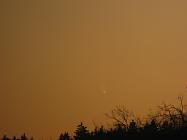 |
Evening mood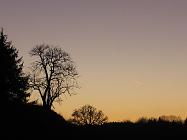 |
| Short before setting Mc Naught is fading. | A few minutes later the comet has disappeared and the mood could be enjoyed. |
Mc Naught at January 10th 2007:
Mc Naught needed a little time to brighten up. During Xmas it was fuzzy, faint and close to the sun. But after its rise in brightness in early 2007, and with more northern declination, it became pretty good visible. Standing higher in the sky this comet could have been really impressive. The opportunity for observation resulted at January 10th at Mt. Wendelstein with the Casio QV 5700. Exposure times were about 1 second. Shortly before setting the following little panoramic shot with Venus was made:

Comet Machholz C/2004q2:
Machholz - Canon Ixus |
Plejades, Machholz
|
Machholz, almost impressive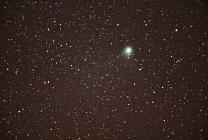 |
Machholz - Bismarck at focus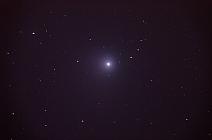 |
This images of comet Machholz have been done with the Canon Ixus, thus on slide film. The Ixus shot, made afocal at Bismarck, has been created from 16 stacked images. Comet Machholz c/2004q2 started in Dezember 2004 as a respectable Xmas comet and reached finally a brightness of about 3 mag. the passage of the comet close to the Plejades cluster was impressive. During this exposure on Fuji 200 the 400 telelens has been used. The 4th image at this row has also been shot focally through Bismarck. More comet links are visibly there.
During creation of the Fuji 200 images, at the same time images at Kodak Panther 1600 have been made. Only the half exposure times was used there (about 15 and 4 minutes). The next row is showing this images:
Plejades, Machholz |
Machholz - Bismarck at focus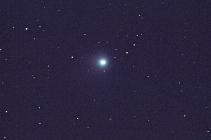 |

Some comets of the younger past:

The comets Hale Bopp and Hyakutake:
Towards the end of the nineties two very spectacular comets arrived in the sky, not only visible with the naked eye, in fact they gained with there enormous brightness and conspicuity the interest of people and press. 1996 Hyakutake crossed the sky with a tail length of ca 100 degrees! Soon after this Hale Bopp ruled the sky.
Hale Bopp at focus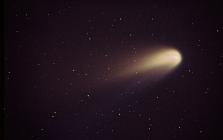
| Hale Bopp above Munich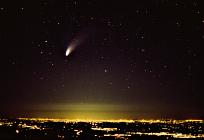
|
Hale Bopp 400 telelens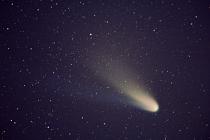
|
| Hale Bopp, seen with Christina | Hale Bopp rules the sky, seen here from Mt. Wendelstein. | Hale Bopp, shot through the 400 telelens. |

Comet Halley:
Halley was my personal step into the world of comet observing. This comet was also the reason for the first astro voyage to the south, Halley was only there good visible. This first spechtling expedition led us 1986 to Teneriffa. The images made there have been created under primitive technical conditions without any motor driven guiding!
Halley - 300 telelens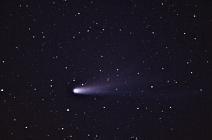
| Halley and Milky Way
|
| Halley was the first comet I was able to observe with the naked eye. | Close to dawn this spectacular view of the comet east of Milky Way has been presented. |

An interesting link to the comet theme: Actual comet infos you'll find at the section comets of the VdS.

 To Bismarck start page
To Bismarck start page |
 To Astrophoto gallery.
To Astrophoto gallery. |
 To Christina and
ULT page To Christina and
ULT page |
 To start page
To start page |
|---|
